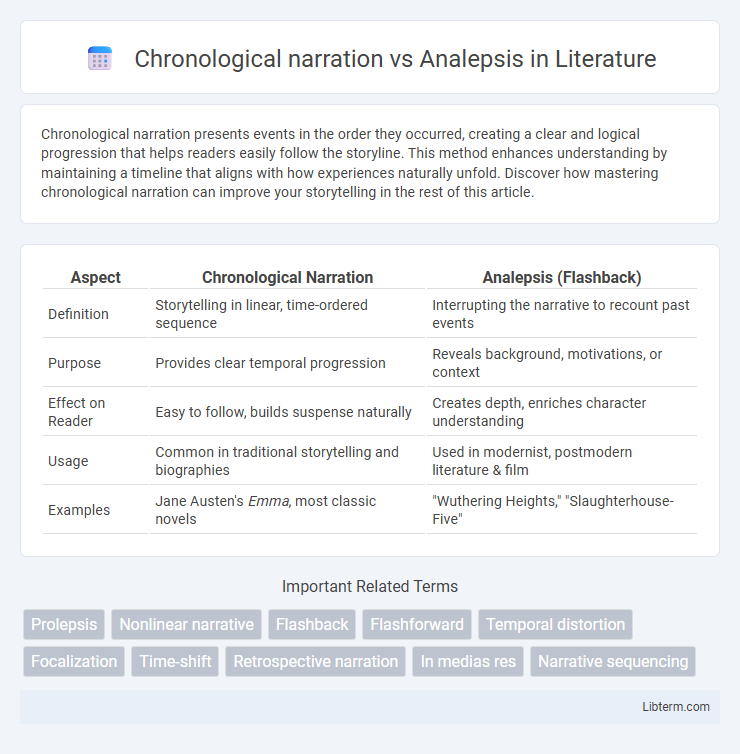Chronological narration presents events in the order they occurred, creating a clear and logical progression that helps readers easily follow the storyline. This method enhances understanding by maintaining a timeline that aligns with how experiences naturally unfold. Discover how mastering chronological narration can improve your storytelling in the rest of this article.
Table of Comparison
| Aspect | Chronological Narration | Analepsis (Flashback) |
|---|---|---|
| Definition | Storytelling in linear, time-ordered sequence | Interrupting the narrative to recount past events |
| Purpose | Provides clear temporal progression | Reveals background, motivations, or context |
| Effect on Reader | Easy to follow, builds suspense naturally | Creates depth, enriches character understanding |
| Usage | Common in traditional storytelling and biographies | Used in modernist, postmodern literature & film |
| Examples | Jane Austen's Emma, most classic novels | "Wuthering Heights," "Slaughterhouse-Five" |
Introduction to Narrative Structures
Chronological narration follows a linear timeline, presenting events in the order they occur, which facilitates straightforward comprehension and clarity in storytelling. Analepsis, commonly known as a flashback, interrupts the sequential flow by revealing past events to provide background or context crucial for character development and plot advancement. Understanding these narrative structures enhances the analysis of storytelling techniques and the manipulation of time in literature and film.
Defining Chronological Narration
Chronological narration presents events in the order they occur, creating a clear and linear storyline that follows a temporal sequence. This narrative style emphasizes cause-and-effect relationships and temporal progression, making it easier for audiences to understand the plot development. Chronological narration contrasts with analepsis, or flashbacks, which disrupt linear time by revisiting past events to provide background or context.
Understanding Analepsis (Flashbacks)
Analepsis, commonly known as flashbacks, interrupts the chronological narration by depicting events that occurred earlier than the current timeline. This technique enriches storytelling by providing background information, character motivations, or context that deepens the audience's understanding of the narrative. Mastering analepsis allows writers to create complex, layered plots that engage readers through temporal shifts and retrospective insights.
Key Differences Between Chronological Narration and Analepsis
Chronological narration presents events in the order they occur, maintaining a linear timeline that enhances clarity and logical progression. Analepsis, or flashback, disrupts this sequence by inserting past events to provide context, character background, or plot development. The key difference lies in their temporal structure: chronological narration follows a straightforward timeline, while analepsis intentionally shifts back in time to reveal critical information.
Narrative Flow: Linear Versus Non-Linear Storytelling
Chronological narration presents events in their natural temporal order, enhancing coherence and maintaining a smooth narrative flow that facilitates reader comprehension. Analepsis, or flashbacks, disrupt linear progression by revisiting past events, creating a non-linear storytelling structure that adds depth and complexity to the narrative. This contrast between linear narration and non-linear analepsis shapes the reading experience by controlling information revelation and emotional impact.
Effects on Reader Engagement and Comprehension
Chronological narration provides a clear, linear progression that enhances reader comprehension by allowing a straightforward understanding of cause and effect, while analepsis, or flashbacks, enriches reader engagement by creating suspense and deepening character backstories. The use of analepsis interrupts the timeline, compelling readers to actively piece together events, which can increase emotional investment but may also challenge cognitive processing. Balancing these techniques optimizes narrative depth and maintains reader interest without sacrificing clarity.
Literary Examples of Chronological Narration
Chronological narration presents events in the order they occur, enhancing narrative clarity and coherence, as seen in Jane Austen's *Pride and Prejudice*, which follows the protagonist's life sequentially. This linear storytelling contrasts with analepsis, or flashbacks, which disrupt temporal order to reveal backstory or character motivations, exemplified by Joseph Conrad's *Heart of Darkness*. Chronological narration facilitates straightforward plot development, allowing readers to experience the story's progression naturally and understand causality within the narrative structure.
Notable Works Employing Analepsis
Notable works employing analepsis include Marcel Proust's "In Search of Lost Time," where fragmented memories provide deep psychological insight, and William Faulkner's "The Sound and the Fury," which uses nonlinear timelines to explore complex family dynamics. Films like Christopher Nolan's "Memento" also utilize analepsis to create suspense and reveal crucial plot details through reverse chronology. These examples highlight how analepsis enriches storytelling by offering layered perspectives beyond chronological narration.
Choosing the Right Technique for Your Story
Selecting between chronological narration and analepsis depends on your story's structure and emotional impact goals. Chronological narration offers clarity and straightforward progression, ideal for linear plots emphasizing cause and effect. Analepsis, or flashbacks, enrich character backstories and reveal hidden motivations, enhancing depth and suspense when used strategically.
Conclusion: The Impact of Narrative Choice
Chronological narration maintains a linear progression of events, fostering clarity and straightforward comprehension, while analepsis (flashbacks) enriches the narrative by providing deeper context and emotional complexity. The choice between these techniques significantly shapes reader engagement and interpretative depth, influencing the story's pacing and thematic emphasis. Effective use of chronological narration versus analepsis can transform the narrative's impact, altering how information is revealed and how audiences connect with characters and plot developments.
Chronological narration Infographic

 libterm.com
libterm.com